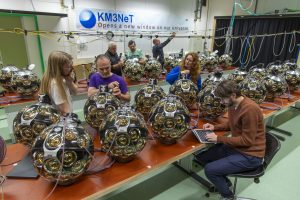KM3NeT
Neutrinos
Nikhef researchers study neutrinos; uncharged subatomic particles that very rarely interact with other matter. This is why neutrinos are sometimes called ‘ghost particles’, because they almost always fly straight through everything. Yet under the right conditions, we can detect neutrinos.
Nikhef is helping to build KM3NeT, a giant neutrino detector at the bottom of the Mediterranean Sea.
Nikhef, together with international partners, is building a large neutrino detector at the bottom of the Mediterranean Sea. This detector is called KM3NeT, which stands for Cubic Kilometre (‘KM3’) Neutrino Telescope (‘NeT’). As the name suggests, KM3NeT is a giant detector that is one kilometre wide, by one kilometre long, by one kilometre high. We sometimes call this detector a telescope because (among other things) we are looking for neutrinos from the distant universe.
We are building the detector at the bottom of the Mediterranean Sea at a depth of 2.5 to 3.5 kilometres. There are several reasons for this. The first reason is simple: we want to build a detector of a cubic kilometre and at that depth there is room for it. The detector needs to be that big to ensure we detect enough neutrinos, despite the small chance of a neutrino interaction.
A second reason is that the water mass above the detector absorbs other particles similar to neutrinos. So the deeper you build, the fewer of those kinds of background particles there are, which ultimately makes our data analysis easier.
A final reason for building so deep is that it has to be very dark, because the seawater is our detection medium. This is because we do not detect neutrinos directly, but indirectly. Neutrinos very rarely interact with other matter. When they do, we can try to detect the resulting particles. The particles created by a neutrino interaction are electrically charged and move through water faster than the speed of light in water (the speed of light in water is lower than the speed of light in vacuum!). As a result, these particles start emitting light that we call Cherenkov radiation. This is the light that is detected in KM3NeT and from it we extract information about the neutrino that caused the light.
The actual KM3NeT detector consists of two parts, which are in different locations. One detector is called KM3NeT/ARCA and is being built about 80 kilometres off the coast of Sicily, Italy. This part of the detector will be used to search for neutrinos from the distant universe.
The second detector is KM3NeT/ORCA and will be located about 40 km off the coast of Toulon, France. This detector part will be a lot more compact than 1 cubic kilometre and will be used to better study the properties of neutrinos.
The building block of the KM3NeT detector is a Digital Optical Module (DOM). One DOM is a glass sphere 42 centimetres in diameter filled with 31 photomultiplier tubes (PMTs). PMTs are like inverted light bulbs: when light hits them, they produce an electric current. We can then read that signal with the electronics in the DOM.
The KM3NeT detectors consist of vertical lines (Detection Units, DUs) of 200 metres (KM3NeT/ORCA) and 700 metres (KM3NeT/ARCA) attached to anchors on the seabed. 18 DOMs are attached to each line.
There will eventually be 230 lines in KM3NeT/ARCA, spaced about 100 metres apart. In KM3NeT/ORCA, there will be 115 lines spaced about 20 metres apart.
A KM3NeT DOM
Two KM3NeT DUs of 18 DOMs each in production at Nikhef
With KM3NeT, researchers hope to answer several open questions about neutrinos. These fall roughly into astrophysical questions and questions that are more about particle physics. A selection:
Astrophysics:
– Where do high-energy neutrinos from the distant universe come from?
– Are there sources there that we already know about from astronomers looking at the sky with conventional telescopes?
– Might we also see gravitational waves coming from there?
– Do we understand what is going on at those distant astrophysical sources?
KM3NeT/ARCA is designed to answer these questions.
Particle physics:
– Given that there are three types of neutrinos, how are the masses of these neutrinos ordered? Which neutrino is the heaviest and which is the lightest?
KM3NeT/ORCA has an excellent chance to be the first experiment on Earth to answer this question with certainty.

KM3NeT-DUs are also made at Nikhef. For photos of the KM3NeT production site for DOMs and DUs, see here. For videos about the DOM production, see here.
Nikhef also designed and developed the cable that runs along the DOMs in the deep sea to supply power and exchange data via optical fibres. This cable (one for each DU) is being built by a specialised Dutch company.
The installation of the detector, in particular the concept of unrolling the DUs was developed by Nikhef in collaboration with NIOZ (Royal Netherlands Institute for Sea Research).
Nikhef is also a major contributor to KM3NeT electronics, mechanics, the optical network, software and analysis of KM3NeT data.
The complete software to select events of interest in real-time and to reconstruct from the detected signals the directions and energies of the detected particles was developed at Nikhef. The in-situ calibration procedures were also developed at Nikhef, including tracking via acoustic signals the DOM positions to the nearest metre, determining their orientation via magnetometers and ensuring synchronisation with nanosecond accuracy. Nikhef also made a major contribution to the analysis software.
Finally, many Nikhef staff have an important role in the organisation of KM3NeT.
For more information about the recent KM3NeT discovery of an ultra-high energetic cosmic neutrino, see here: https://www.nikhef.nl/recordneutrino


